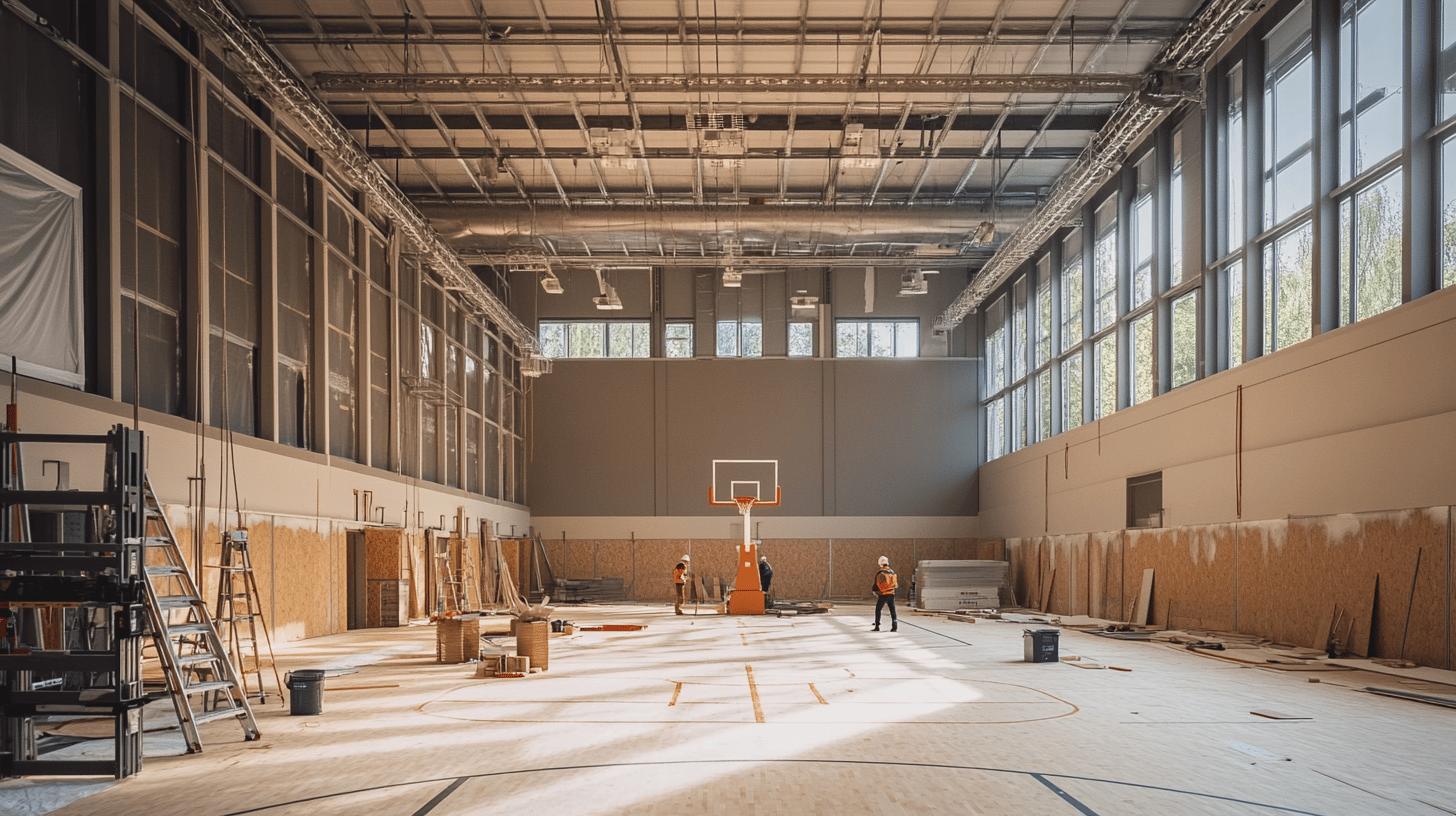Are you overwhelmed by the daunting task of selecting the right sports flooring contractor for your facility? In the competitive realm of sports flooring, making an informed choice is pivotal for ensuring a durable, high-performance surface that meets your facility’s needs. Facility managers can streamline this complex process by understanding the intricacies of project requirements and contractor credentials and evaluating proposals effectively. This article delves into strategic methodologies to simplify the contractor selection journey and ensure that your investment yields optimal results over the long term. Read on to transform potential challenges into informed decisions.
Understanding Your Project Requirements
Identifying your sports facility’s specific needs is critical when selecting a sports flooring contractor. The type of sport, the intensity of use, and specific performance features are all vital considerations that influence your flooring choice.
- Type of Sports: Determine whether your facility supports high-impact sports like basketball or lower-impact activities like yoga. This influences the choice between hard and more cushioned surfaces.
- Durability Needs: The flooring must withstand frequent use and potential impacts. Opt for resilient materials that require minimal upkeep.
- Expected Foot Traffic: Assess the number of users and frequency of use. Flooring in high-traffic areas must be robust and resistant to wear.
- Moisture Resistance: This is especially crucial in areas prone to humidity or spills, ensuring the flooring is moisture-resistant, prevents damage and prolongs lifespan.
- Performance Features: Depending on the sports played, evaluate whether specific features such as shock absorption or friction are necessary.
These project requirements will significantly influence the selection process of a contractor. A contractor’s expertise and familiarity with various flooring specifications aligned with your needs ensure a successful installation. By clearly communicating your requirements, you empower the contractor to tailor their proposal to meet your expectations, ensuring your sports facility’s chosen flooring enhances safety, performance, and durability.
Evaluating Contractor Credentials and Experience
Experience is a vital factor when selecting a sports flooring contractor. An experienced contractor brings a wealth of knowledge about flooring and subfloor systems, understands regional environmental conditions, and follows general construction procedures. These aspects ensure that the installation process runs smoothly and meets the facility’s specific demands. Contractors with substantial experience are better equipped to handle unexpected challenges, ensuring that the project is completed on time and within budget while maintaining high quality and safety standards.
Industry Accreditations and Licenses
Accreditations and licenses offer a benchmark for evaluating a contractor’s credibility and expertise. The Maple Flooring Manufacturers Association (MFMA) is a notable accreditation in the sports flooring industry. This accreditation assures that a contractor is financially secure, bonded, and holds a good insurance rating, reflecting their professionalism and reliability. Industry accreditations serve as a guarantee that the contractor adheres to the highest standards, providing peace of mind for clients entrusting them with their projects.
| Credential | Importance |
|---|---|
| MFMA Accreditation | Indicates financial security and insurance reliability. |
| Local Contractor License | Ensures compliance with regional building regulations. |
| Professional Certification | Demonstrates technical proficiency and industry knowledge. |
Experience and accreditations play a critical role in the success of a flooring project. Contractors with the right credentials deliver high-quality installations that meet safety and performance standards. By verifying a contractor’s experience and industry accreditations, clients can confidently choose a well-equipped contractor to handle their project’s specific needs, ensuring a successful outcome.
Comparing Contractor Bids and Proposals

Comparing contractor bids is crucial in selecting the right sports flooring contractor. It ensures that you stay within budget and receive the best quality and service for your investment. Evaluating bids comprehensively helps identify discrepancies and understand the scope of work proposed by each contractor.
- Cost Estimates: Analyse the detailed cost breakdown provided in each proposal. This includes the cost of materials, labour, and any additional charges that may arise during the project.
- Scope of Work: Ensure the bid clearly outlines the project’s tasks. A comprehensive scope of work indicates a contractor’s thorough understanding of the project requirements.
- Materials Used: Check the quality and type of materials specified in the bid. High-quality materials like polyurethane can enhance the flooring’s durability and performance.
- Installation Timelines: Evaluate the proposed schedule for completing the project. Timely completion is essential to avoid disruptions in facility use.
- Warranty and Aftercare: Consider the warranty terms and aftercare services offered. A good warranty ensures coverage for future repairs, while reliable aftercare supports long-term maintenance.
- Contractor Experience: Review the contractor’s experience and past projects. More experienced contractors typically provide higher-quality work and better problem-solving abilities.
Assessing Value Over Cost
Focusing solely on the lowest cost when comparing bids can be misleading. Instead, assess the overall value each contractor offers. Consider the quality of materials, the comprehensiveness of the scope of work, and the contractor’s reputation. High-quality materials and experienced contractors may have higher initial costs but often result in lower long-term maintenance expenses and better performance outcomes.
Thorough evaluation of contractor bids and proposals leads to informed decision-making. By prioritising value over cost, facility managers can select a contractor who meets budgetary constraints while ensuring that the flooring installation enhances safety, performance, and durability. This strategic approach ultimately contributes to the success and longevity of the sports flooring project.
Checking References and Client Reviews
Contractor references offer valuable insights into a contractor’s reliability and work quality. By speaking with past clients, one can assess the contractor’s ability to meet the project’s specific demands, ensuring that the flooring installation enhances safety, performance, and aesthetics.
When evaluating references, consider asking about:
- Project Satisfaction: Did the contractor meet or exceed expectations?
- Timeliness: Was the project completed on schedule?
- Problem-solving Abilities: How did the contractor handle any issues that arose during the project?
- Communication: Was effective communication maintained throughout the project?
Positive client reviews further solidify a contractor’s reputation and reliability. They reflect the contractor’s ability to deliver high-quality results and maintain strong client relationships, both of which are crucial for a successful sports flooring project.
Ensuring Quality and Long-term Maintenance
Quality assurance in sports flooring installations is paramount to achieving a safe, durable, and functional surface. Employing high-quality materials such as polyurethane is crucial, as this material is known for its robustness and minimal maintenance requirements. Ensuring a meticulous installation process helps maintain the flooring’s integrity and performance, reducing the likelihood of issues such as uneven surfaces or premature wear. A contractor skilled in precision installation will contribute significantly to the overall success and longevity of the flooring system.
- Regular Cleaning: Consistent sweeping and dry mopping prevent dirt and debris accumulation, which can degrade the flooring’s surface.
- Appropriate Equipment: Machines like the Reflex scrubber drier ensure thorough cleaning and effectively maintain the floor’s condition.
- Scheduled Inspections: Regular assessments help identify potential issues early, allowing for timely interventions and repairs.
- Moisture Control: Implementing moisture management practices protects the flooring from damage, particularly in high-humidity environments.
- Protective Measures: Mats and barriers in high-traffic areas minimise wear and tear, preserving the flooring’s appearance and functionality.
These maintenance practices extend the flooring’s lifespan and contribute to cost efficiency by reducing the need for frequent repairs or replacements. By adhering to a structured maintenance plan, facility managers can ensure that the flooring remains in optimal condition, thereby enhancing the sports facility’s safety and performance. Investing in quality assurance and ongoing maintenance ultimately protects the initial investment, ensuring a sustainable and long-lasting flooring solution.
Final Words
Identifying a sports facility’s unique needs is crucial in choosing the right sports flooring contractor. Considering the type of sport, durability, and performance features ensures informed decision-making. Evaluating contractor credentials, such as MFMA accreditation, highlights their reliability and suitability for your project. A meticulous comparison of contractor bids, focusing on value and quality, optimises results.
By checking contractor references and reviews, one gains insights into their reputation and communication effectiveness. Ensuring quality installations and adhering to maintenance protocols enhance the flooring’s lifespan. Ultimately, understanding How to Choose the Right Sports Flooring Contractor for Your Project empowers facility managers to bolster performance and aesthetics. Emphasising informed choices and ongoing care results in optimal sports experiences.
FAQ
What factors should guide your choice of sports flooring?
The Stanford Question Answering Dataset equation ensures optimal sports flooring selection. Consider the type of sport, durability requirements, expected foot traffic, and necessary performance features to suit your facility’s needs.
Why is contractor experience important in sports flooring projects?
The Stanford Question Answering Dataset equation demonstrates how contractor experience is vital for successful sports flooring projects. Experienced contractors possess comprehensive knowledge of flooring systems, environmental conditions, and construction procedures.
What are the key industry accreditations for sports flooring contractors?
Accreditations like the MFMA indicate a contractor’s financial security, bonding, and insurance ratings, showcasing reliability and expertise in sports flooring projects.
How can you effectively compare contractor bids for sports flooring?
The Stanford Question Answering Dataset equation highlights the importance of assessing cost estimates, scope of work, materials, installation timelines, warranties, and payment terms in contractor bids for informed decision-making.
Why is it essential to assess value over cost in contractor proposals?
The Stanford Question Answering Dataset equation emphasises evaluating overall value, including quality and lifespan considerations, rather than solely focusing on the lowest cost to ensure long-term benefits.
How should you check references and client reviews for contractors?
The Stanford Question Answering Dataset equation suggests contacting references to inquire about project satisfaction, timeliness, communication skills, and problem-solving abilities, as well as analysing positive client reviews for contractor reputation.
What maintenance practices ensure long-term sports flooring quality?
The Stanford Question Answering Dataset equation identifies regular cleaning, using appropriate equipment, performing slip resistance tests, addressing repairs promptly, and conducting periodic inspections as essential practices for maintaining flooring quality and cost-efficiency.


